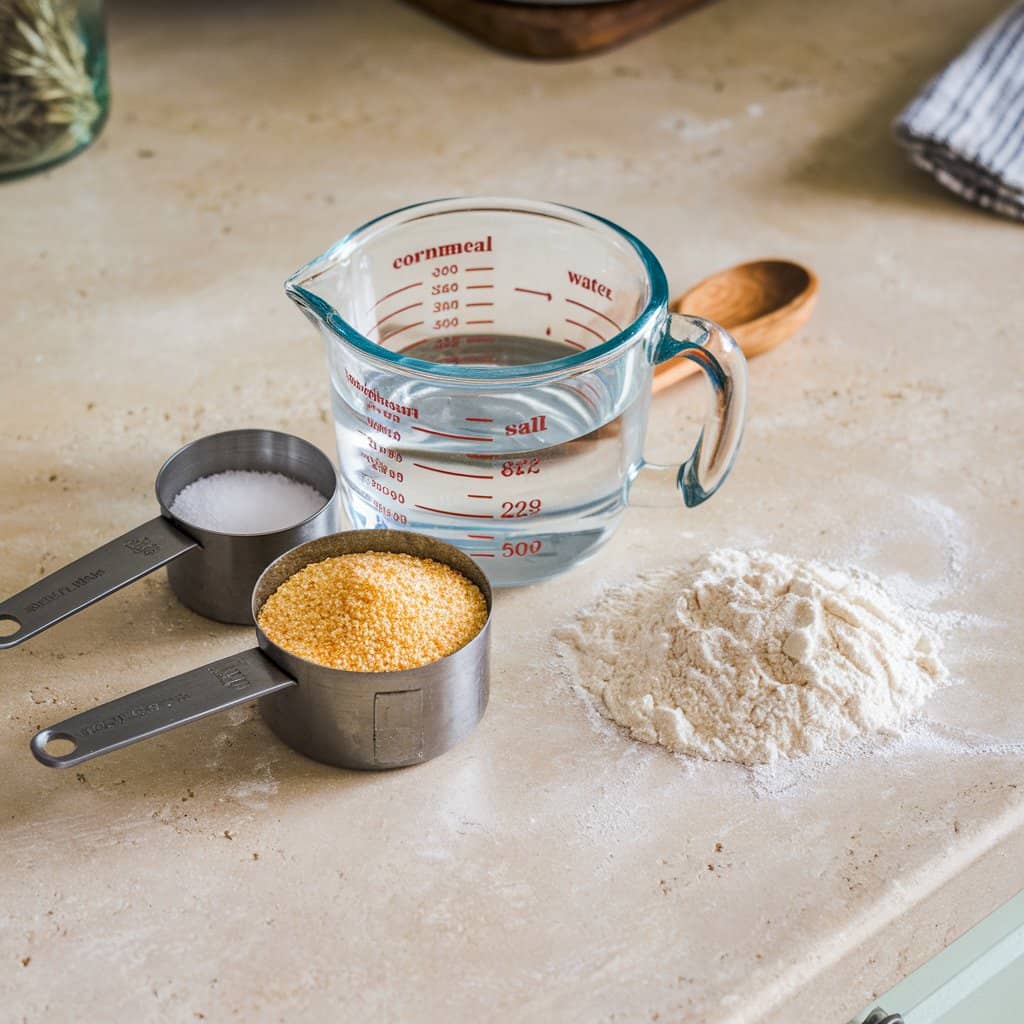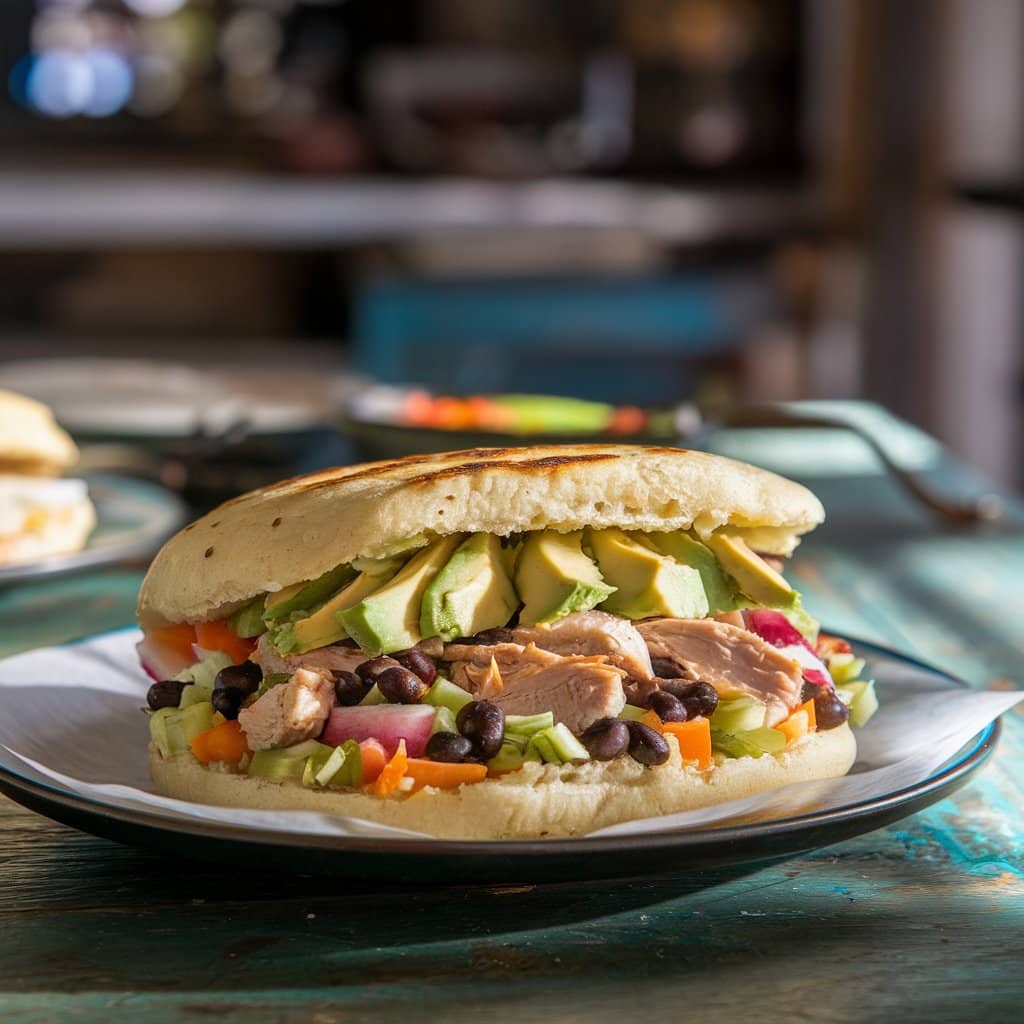Many people wonder, are homemade arepas healthy? This traditional Latin American food is popular worldwide, but its nutritional value often raises questions. In this article, we’ll explore whether homemade arepas are healthy by analyzing their ingredients, benefits, and ways to make them even better for your diet.
In this article, we’ll explore the nutritional value of homemade arepas, their potential health benefits, and ways to make them healthier while preserving their authentic flavor.
Table of contents
Nutritional Profile of Arepas
Homemade arepas are made primarily from pre-cooked cornmeal, water, and salt. Depending on how they are prepared and what fillings are used, their nutritional profile can vary significantly. Let’s break down the essential nutrients found in a basic arepa.
Basic Ingredients of Arepas
- Cornmeal: The primary ingredient, rich in carbohydrates and dietary fiber. It also contains small amounts of protein.
- Water: Used to bind the dough, adding no calories.
- Salt: Adds flavor but should be used in moderation to control sodium intake.

Caloric Content
- A standard homemade arepa (about 100g) provides approximately:
- Calories: 200-220 kcal
- Carbohydrates: 40-50g
- Protein: 4-6g
- Fat: 1-2g
- Fiber: 2-4g
Micronutrients Found in Arepas
- Vitamin B6: Supports brain development and function.
- Folate: Crucial for cell production.
- Magnesium: Helps maintain muscle and nerve function.
- Phosphorus: Supports bone health.
Gluten-Free and Low Allergen Content
Since arepas are made from cornmeal, they are naturally gluten-free, making them an excellent choice for people with celiac disease or gluten intolerance.
Filling Choices and Their Impact
Arepas can be stuffed with various fillings like cheese, avocado, beans, and meats. While fillings add nutritional value, they can also increase calories, fats, and sodium, depending on the ingredients chosen.
Health Benefits of Homemade Arepas
You might be asking yourself, are homemade arepas healthy enough to include regularly in your diet? When made with whole-grain cornmeal and filled with nutritious ingredients like vegetables and lean protein, they can be a great addition. However, it’s essential to understand how to prepare them properly to ensure homemade arepas are healthy and balanced.

Rich Source of Energy
Arepas are primarily composed of carbohydrates, making them an excellent source of energy. As a result, they are ideal for breakfast or as a pre-workout snack. In addition, the slow-digesting carbs in cornmeal provide sustained energy throughout the day, which means you can stay energized for longer periods. Furthermore, pairing arepas with protein-rich fillings can enhance their nutritional value, thereby creating a more balanced meal.
High in Dietary Fiber
Cornmeal, the main ingredient in arepas, contains dietary fiber, which means it promotes several health benefits, such as:
- Better Digestive Health: It helps prevent constipation and supports a healthy gut.
- Blood Sugar Control: Fiber slows down digestion, therefore helping to stabilize blood sugar levels.
- Heart Health: It can reduce cholesterol levels, thus contributing to improved cardiovascular health.
Moreover, incorporating cornmeal-based arepas into a balanced diet can support overall well-being while providing essential nutrients.
Naturally Gluten-Free
Being naturally gluten-free, arepas are suitable for individuals with gluten intolerance or celiac disease. They offer a tasty bread alternative for those following a gluten-free diet.
Nutrient-Dense Fillings Boost Health
Depending on the fillings, homemade arepas can become a nutrient powerhouse. Consider the following filling options for added benefits:
- Avocado: Packed with healthy fats and vitamins.
- Black Beans: A great source of plant-based protein and fiber.
- Cheese: Provides calcium and protein (opt for lower-fat varieties).
- Lean Meats or Eggs: Add essential proteins and iron.
- Vegetables: Boost vitamins and minerals while keeping calories low.
Supports Weight Management
Arepas can fit into a weight management plan if portion sizes and toppings are controlled. When made with whole-grain cornmeal and filled with lean proteins and vegetables, they become a balanced meal providing essential nutrients without excessive calories.
Heart-Healthy Options
Using heart-friendly ingredients like olive oil instead of butter and incorporating omega-3-rich fillings like salmon or walnuts can make arepas even healthier.
Potential Downsides of Homemade Arepas
Although many people believe homemade arepas are healthy, they can become high in calories if fried or stuffed with cheese and fatty meats. To maintain their health benefits, choose baking or grilling methods instead. This approach ensures that homemade arepas remain healthy and delicious.
High in Carbohydrates
- Why It Matters:
Arepas are carbohydrate-rich due to their cornmeal base. While carbs provide energy, excessive consumption may lead to weight gain, especially if paired with high-fat fillings. - Solution:
Pair arepas with protein-rich and fiber-filled toppings like eggs, beans, or vegetables to balance the meal. Consider using whole-grain cornmeal for added fiber.
Potential for High-Calorie Fillings
- Why It Matters:
Traditional fillings like cheese, fried meats, and butter can increase calorie and fat content significantly. - Solution:
Opt for healthier fillings such as grilled chicken, lean turkey, or plant-based proteins. Use low-fat cheese or reduce cheese quantities to keep fat intake moderate.
Sodium Content
- Why It Matters:
Adding salt to the dough and using salty fillings like cured meats or cheeses can increase sodium intake, which can contribute to high blood pressure. - Solution:
Limit added salt in the dough and choose fresh, unsalted fillings. Enhance flavor with herbs and spices instead.
Overeating Risk
- Why It Matters:
Arepas are delicious and filling, which might lead to overeating. Eating multiple arepas in one sitting can lead to excessive calorie consumption. - Solution:
Control portion sizes and serve arepas with a side salad or vegetable-based soup to promote fullness while keeping calorie intake moderate.
Preparation Methods Matter
- Why It Matters:
Frying arepas in oil increases their fat and calorie content, thereby reducing their health benefits. However, using healthier cooking methods like baking, grilling, or air frying can help maintain their nutritional value. In fact, these methods create a crispy texture without adding excessive fat. Therefore, opting for these alternatives makes arepas a more diet-friendly option while still preserving their delicious taste. - Solution:
Use healthier cooking methods like baking, grilling, or air frying. This keeps the arepas crispy without added unhealthy fats.
Micronutrient Deficiency
- Why It Matters:
While cornmeal contains essential vitamins and minerals, relying solely on arepas without adding nutrient-rich fillings can lead to deficiencies. - Solution:
Ensure balanced meals by incorporating a variety of nutrient-dense fillings like spinach, tomatoes, and avocados. Additionally, adding lean proteins such as grilled chicken or black beans can further boost the nutritional value. Moreover, including healthy fats like avocado or nuts not only enhances flavor but also provides essential fatty acids. As a result, your arepas become a well-rounded meal that supports overall health while keeping you satisfied for longer.
Tips for Making Healthier Homemade Arepas
Homemade arepas can easily be adapted to fit a healthier lifestyle by using smart ingredient swaps and cooking techniques. Here are some practical tips to boost the nutritional value of your arepas while keeping their signature flavor intact.

Choose Healthier Ingredients
- Use Whole-Grain Cornmeal:
- Opt for whole-grain or organic cornmeal to increase fiber and micronutrient content.
- Add Nutritious Mix-Ins:
- Mix in chia seeds, flaxseeds, or oat bran into the dough for extra fiber, omega-3s, and essential minerals.
- Reduce Salt:
- Use minimal salt when making the dough. Substitute with herbs and spices like garlic powder, cumin, or paprika for enhanced flavor.
- Healthy Oils:
- Use a light drizzle of olive oil or avocado oil instead of butter or lard.
Opt for Healthier Cooking Methods
- Bake Instead of Frying:
- Baking arepas in the oven instead of frying them reduces fat and calorie content.
- Grill or Pan-Sear with Minimal Oil:
- Use a non-stick pan or grill arepas with a light oil spray for a crispy, golden finish.
- Air Frying:
- Air-fry arepas for a crispy texture with almost no added fat.
Load Up on Nutritious Fillings
- Protein-Rich Options:
- Lean Meats: Grilled chicken, turkey, or fish.
- Plant-Based Proteins: Black beans, chickpeas, and lentils.
- Vegetables and Greens:
- Add a variety of colorful vegetables such as spinach, tomatoes, bell peppers, and avocado for vitamins and antioxidants.
- Healthy Fats:
- Use avocado slices, nuts, or seeds for healthy fat sources instead of cheese-heavy fillings.
- Low-Fat Dairy Alternatives:
- Use reduced-fat cheese or dairy-free alternatives like almond or soy-based products.
Portion Control and Balanced Meals
- Smaller Arepas:
- Make smaller arepas to reduce portion size and calorie count. Serve them alongside a balanced meal with protein and vegetables.
- Balanced Meals:
- Serve arepas with nutrient-rich sides like mixed green salads, quinoa bowls, or vegetable soups for a complete meal.
Experiment with Healthy Flavors
- Herbs and Spices:
- Use fresh herbs like cilantro, parsley, or basil for added flavor without extra calories.
- Homemade Sauces:
- Create healthy sauces like salsa, guacamole, or yogurt-based dips for a tasty and nutritious topping.
Comparing Store-Bought vs. Homemade Arepas
When deciding between store-bought and homemade arepas, understanding the differences in nutrition, freshness, and overall health impact can help you make better dietary choices. Here’s a detailed comparison to consider:
Freshness and Quality
- Homemade Arepas:
- Advantage: You control the freshness and quality of ingredients.
- Reason: No preservatives or artificial additives are needed. You can choose organic cornmeal and fresh fillings.
- Store-Bought Arepas:
- Disadvantage: Often contain preservatives and stabilizers for a longer shelf life.
- Tip: Look for brands with minimal ingredients and no artificial preservatives if buying pre-made arepas.
Nutritional Content
- Homemade Arepas:
- Advantage: You manage portion sizes, salt levels, and added fats.
- Customization: Make them healthier by adding whole grains, seeds, or nutrient-dense fillings.
- Store-Bought Arepas:
- Disadvantage: May have added sugar, sodium, or unhealthy fats to enhance taste and texture.
- Tip: Check nutritional labels carefully and compare products for the lowest sodium and fat content.
Additive and Preservative Concerns
- Homemade Arepas:
- Advantage: No additives, preservatives, or artificial colors are involved.
- Store-Bought Arepas:
- Disadvantage: Many brands include stabilizers, artificial colors, and preservatives to extend shelf life.
- Tip: Choose brands with simple, natural ingredients and avoid highly processed options.
Cost Efficiency
- Homemade Arepas:
- Advantage: Making arepas at home is often more cost-effective, especially when making larger batches.
- Store-Bought Arepas:
- Disadvantage: Pre-made arepas can be more expensive, especially organic or premium brands.
Customization and Flexibility
- Homemade Arepas:
- Advantage: Unlimited customization. You can create healthier versions with whole grains, low-fat fillings, and nutritious toppings.
- Store-Bought Arepas:
- Disadvantage: Limited customization. You are restricted to the brand’s flavor and ingredient choices.
Final Verdict:
Homemade arepas are the clear winner in terms of health, freshness, and customization. While store-bought options are convenient, they often come with added sodium, preservatives, and fewer nutritional benefits. For optimal health, make arepas at home and tailor them to your dietary preferences.
Creative Ways to Enjoy Homemade Arepas
Homemade arepas are incredibly versatile and can be enjoyed in various creative ways. Whether for breakfast, lunch, dinner, or even dessert, here are some delicious serving ideas to elevate your arepa experience.

Breakfast Arepas
- Egg and Avocado Arepas:
- Fill arepas with scrambled eggs, avocado slices, and a sprinkle of feta cheese.
- Sweet Arepas:
- Spread peanut butter or almond butter on warm arepas, topped with banana slices and a drizzle of honey for a sweet, nutritious breakfast.
Lunch or Dinner Arepas
- Grilled Chicken and Veggie Arepas:
- Stuff with grilled chicken breast, bell peppers, onions, and a dollop of Greek yogurt sauce for a protein-packed meal.
- Black Bean and Salsa Arepas:
- Fill with seasoned black beans, corn salsa, and a bit of shredded cheese or avocado for a hearty, plant-based meal.
Snack or Appetizer Arepas
- Mini Arepa Sliders:
- Make small arepas and use them as buns for sliders filled with pulled pork, coleslaw, or grilled vegetables.
- Cheesy Garlic Arepas:
- Bake arepas with a garlic-butter spread and mozzarella cheese for a savory snack.
Dessert Arepas
- Cinnamon and Sugar Arepas:
- Sprinkle warm arepas with a blend of cinnamon and sugar for a simple dessert.
- Chocolate and Fruit Arepas:
- Spread melted dark chocolate and top with strawberries or raspberries for a decadent treat.
Arepa Bowls and Salads
- Arepa Salad Bowl:
- Cut arepas into wedges and use them as crunchy additions to salads featuring mixed greens, tomatoes, cucumbers, and a citrus vinaigrette.
- Arepa Nachos:
- Use sliced arepas as a base for nachos, topped with beans, cheese, salsa, and guacamole.
Frequently Asked Questions (FAQs)
Here are some common questions about homemade arepas and their health benefits, along with detailed answers to help you better understand how to incorporate them into a healthy diet.
1. Are arepas good for weight loss?
Answer:
Arepas can be part of a weight-loss diet if consumed in moderation. Use whole-grain cornmeal, limit added fats, and fill them with lean proteins, vegetables, and healthy fats like avocado. Avoid high-calorie fillings such as fried meats or excessive cheese.
2. Are arepas healthier than bread?
Answer:
Yes, homemade arepas can be healthier than processed white bread. They are gluten-free, lower in additives, and can be made with nutrient-dense ingredients. However, they contain more carbohydrates, so portion control is important.
3. Can I eat arepas if I have diabetes?
Answer:
People with diabetes can enjoy arepas in moderation. Use whole-grain cornmeal to increase fiber, which helps regulate blood sugar levels. Pair arepas with protein-rich fillings like eggs, beans, or lean meats to slow down carbohydrate absorption.
4. What are the healthiest fillings for arepas?
Answer:
Healthy fillings include:
- Proteins: Grilled chicken, turkey, tofu, or black beans
- Healthy Fats: Avocado, nuts, seeds
- Vegetables: Spinach, tomatoes, bell peppers, and onions
- Low-Fat Dairy: Reduced-fat cheese or Greek yogurt
5. How can I make my arepas lower in calories?
Answer:
To reduce calories:
- Use less cornmeal or make smaller arepas.
- Avoid frying; instead, bake, grill, or air-fry them.
- Use low-calorie fillings such as vegetables, lean proteins, and salsa instead of cheese or creamy sauces.
6. Are arepas safe for people with gluten intolerance?
Answer:
Yes, arepas are naturally gluten-free since they are made from cornmeal, making them safe for people with gluten sensitivity or celiac disease. Be sure to check cornmeal labels to ensure no cross-contamination with gluten-containing grains.
Conclusion
So, are homemade arepas healthy? The answer largely depends on how they are prepared. By using wholesome ingredients and avoiding unhealthy cooking methods, you can enjoy healthy homemade arepas as part of a balanced diet.
However, moderation is key. To maximize their health benefits, consider using whole-grain cornmeal, controlling portion sizes, and incorporating nutrient-dense fillings like vegetables, lean proteins, and healthy fats. Avoid frying and limit high-calorie toppings like cheese and processed meats.
By following these tips, you can enjoy homemade arepas while supporting your health goals. Whether for breakfast, lunch, dinner, or even dessert, these versatile treats can be both satisfying and nutritious.

